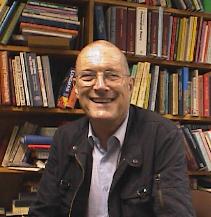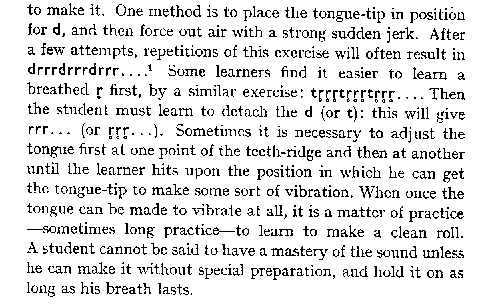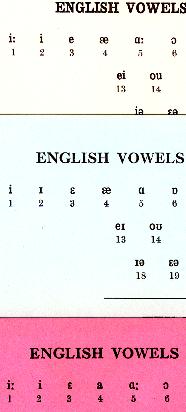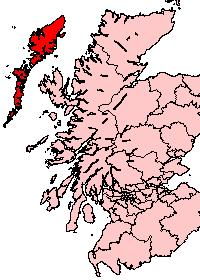DEPARTMENT OF SPEECH, HEARING & PHONETIC SCIENCES UCL Division of Psychology & Language Sciences |
 |
John Wells’s phonetic blog
|
 |
| Wednesday 15 November 2006 | Fricative /t/Jack Windsor Lewis, referring in his blog to my 13 November entry, says ‘I wish John had given us some examples of the Irish use of a fricative for "intervocalic coda /t/"’. I was referring to Irish English /t/ when it is intervocalic (= between vowels) and in coda position (= at the end of a syllable). I was therefore thinking of the /t/ in examples such as atom, bottom, jetty, ditto; get off, shut up, quite easy, wait a second I might have added utterance-final position: a lot, who's that, very late, all right In all of these cases the usual southern Irish sound is a kind of alveolar slit fricative. It is an example of lenition (weakening), a characteristic feature of Irish consonants in certain positions. In Accents of English (p. 429) I used the symbol [t̨] for this sound, employing what was then the official IPA diacritic for ‘opener articulation’, an ogonek (reversed subscript comma). At the 1989 Kiel convention the IPA changed this to a down tack, which means that the proper symbol would now be [t̞] (so far as fonts and browsers allow). That is the symbol which Jeffrey Kallen correctly uses in his article ‘The influence of the languages of Ireland and Scotland on linguistic varieties in northern England’. The contrast between /t/, /s/ and /ts/ is maintained: hit ≠ hiss ≠ hits. (The first two end in fricatives, the last in an affricate.) I used to tell people that you get this kind of /t/ in Scouse (the accent of Liverpool) as well: it’s one of the typical Irish characteristics of Scouse. However Kevin Watson, in his article ‘The realization of final /t/ in Liverpool English’, does not consider any intermediate possibility between [t] and [h]. That is also the finding that Kallen reports for Liverpool. So I seem to have been wrong. Oh well, we usually classify [h] as a fricative, too. PS: Kevin now tells me, “There are indeed intermediate 'slit-t' varieties in Liverpool — the point in that article was that [h] is only possible in certain environments and those environments seem to have extended yet are still tightly constrained. So in a word like 'quite' or 'internet' you'd get a slit-t (of varying kinds, I've called them e.g. 'dynamic sibilants' and 'canonical sibilants' although I'm not happy with those terms) but in 'what' or 'biscuit' you'd get [h].” |
|
| Tuesday 14 November 2006 | Biblical namesI was listening to the radio in the bath at midday on Saturday (as one does) when to my amazement I heard Nigel Rees, the presenter of the BBC R4 programme Quote Unquote, pronounce the name of the Old Testament character Job as /dʒɒb/, just like its homograph job ‘work’. But anyone with any kind of Christian upbringing or religious education, or with just a good knowledge of biblical allusions in literature, knows that we call him /dʒəʊb/, rhyming with robe — don’t they? Apropos of that, my colleague Kwan-hin Cheung was complaining about the lack of an IPA pronouncing dictionary of biblical names. The only such dictionaries available are American and, in the way of American dictionaries, use awkward respelling systems instead of transparent IPA. When I saw him recently in Hong Kong, Kwan-hin was trying to persuade me that I ought to write a dictionary of biblical names, since my father’s occupation (he was an Anglican priest) plus my classical education means that I already have a fairly good knowledge of them. However, I find that Max Mangold, the author of the Duden Aussprachewörterbuch (blog, 26 Oct.), has already done the job (that’s /dʒɒb/). A pronouncing and phonetic dictionary of Biblical names, by Max Mangold and See-Young Cho, was published by Universität des Saarlandes in 1994. Better still, it’s available on-line. Mangold and Cho transcribe into RP. But since they base themselves on American sources, I’m sorry to report that Isaiah appears American-style as /aɪˈzeɪə/ rather than as the British /aɪˈzaɪə/. |
|
| Monday 13 November 2006 | Perceptions of /æ/Some weeks ago my German colleague Detlev Blanke, who is an excellent linguist but not a specialist phonetician, was telling me that he and his wife had taken a short holiday-cum-English language course in the Republic of Ireland. They were delighted with the holiday aspect, but Detlev was worried about whether Irish English was a suitable model for learners such as himself to be exposed to. In particular, he complained, the Irish EFL teachers mispronounced — as he saw it — the English /æ/ vowel of that bad man, making it [a] instead of the [ɛ] he was expecting. I had to tell him that (i) on balance I think it is a good thing, rather than a bad thing, for EFL learners to be exposed to more than one variety of English; and that (ii) if he is concerned about deviation from the RP standard, the things that might well worry him about Irish English could include their use of plosives for /θ, ð/ and of a fricative for intervocalic coda /t/, but not the quality of their /æ/, which is well within the range of variability to be found within England, let alone the remainder of the British Isles. I think the problem is really the institutionalized perception in central and eastern Europe that English /æ/ is to be mapped onto a variety of the local short /e/ (phonetically [ɛ]) and not onto the local short /a/. In German, the English-derived loanword Flashback is pronounced /ˈflɛʃbɛk/. Polish has borrowed flash as flesz, Russian as флеш, Serbian as fleš. All too often, this leads to a failure by Germans and east Europeans to make any distinction in English between the vowels of pan and pen, bat and bet, or indeed flash and flesh. (Speakers of Spanish and Japanese, on the other hand, map English /æ/ onto their own /a/, and may therefore fail to distinguish pan and pun, bat and butt, flash and flush.) The east European treatment of /æ/ rather shocks us native speakers of English — British ones, at any rate. We think of our TRAP vowel not as a kind of [e], but as a kind of [a]. After all, we call Málaga /ˈmæləgə/, Hamburg /ˈhæmbɜːg/, Poznań /ˈpɒznæn/ and Novi Sad /ˌnɒvi ˈsæd/. We expect the equivalence to work the other way round, too. |
|
| Friday 10 November 2006 | More trilling experiencesPersonally, I’ve always found it difficult to combine a lingual trill with palatalization, as in Russian рис [rʲis] ‘rice’ or Irish rí [rʲiː] ‘king’. But not everyone does. David Marjanović, whose native language is German, writes, “I had four years of Russian in school. I immediately got the palatalised alveolar trill right: I had already taught myself to palatalise, and when I put my tongue into the palatalised position and try to say r, the palatalised alveolar trill is the automatic result. A palatalised uvular trill is much harder (and hurts because I have to stretch a part of the tongue I normally don't stretch); I'm still not sure if it sounds convincing. In contrast, the plain alveolar trill escaped me till last year when I had learned that my native trill was uvular and the other one was alveolar. “Pulmonic-ingressive trills (he continues) are for me almost as easy as pulmonic-egressive ones. Ejective ones are easy, too — in fact, that way it's easier to consciously produce a trill with a given number of contacts. I can't seem to manage implosive or clicking ones. However, the velaric-egressive retroflex trill is easy (I sometimes use it as an alternative to humming or whistling, though the constant retroflexion soon hurts), and with my mouth closed I can still get it to up to 5 contacts (while moving the point of articulation forwards). Maybe that's what Taniguchi-san is doing. Velaric-egressive alveolar trills don't seem to work. “Finally (he concludes), here's how I do an ordinary alveolar trill: Starting from my default tongue position (raising the tip and the lamina from there produces a laminal-alveolar stop -- but then my native alveolar consonants are laminal, so I'm not sure if that can help a native English speaker), I raise the blade. Everything in front of the blade follows maybe halfway. Then I use a lot of muscle force to fix the tongue in that position — certainly far more than necessary, because it hurts. And then I squeeze air through as in my native uvular trill: the space above the tongue is so narrow that the airstream regularly rips off, so the air gets through in separate bubbles, not continuously as in a fricative.” I don’t think it ought to actually hurt, ought it? I don’t believe that speaking Italian, Spanish, or Serbian requires one to inflict pain on oneself. David refers us to some sound files of epiglottal fricatives and stops on-line here. But there are no files of epiglottal trills. | [rʲ] |
| Thursday 9 November 2006 | The thrill of trillsYesterday’s discussion has evoked a number of reactions. Biljana Čubrović promises to look for some advice from Serbian sources. Masaki Taniguchi tells me he has been practising what he thinks is an epiglottal trill. He says, “I thought it was this sound when I was imitating a voice produced by a Japanese comedian, who sounded as if he was growling while speaking. I think it sounds like a dog or a person growling or trying to clear the throat.” That seems reasonable to me. An epiglottal trill is the one trill some of us can produce that is not used as a speech sound in any language (as far as I know... though Wikipedia suggests that it is found in ‘the northern dialect’ of Haida, an endangered language all of whose living speakers are aged over 70). Masaki goes on to say, “I have just tried [r] with my mouth closed. I was able to do it, although it was difficult. Would it be called a nasal(ized) alveolar trill?”. I think a straightforward nasalized trill would be extremely difficult or even impossible, because nasal escape of air would mean insufficient air pressure in the oral cavity to sustain a trill. The only possibility would be to exploit the click mechanism, i.e. to have a pulmonic velar nasal simultaneously with a trill using orally initiated air. I can’t make any trills on an ingressive airstream, and suspect that no one can; so we would have to have a reverse-click mechanism, i.e. an egressive velaric airstream. I find an ejective alveolar trill (egressive glottalic airstream) quite easy to do, but a reverse-click one much harder. If Masaki has produced a reverse-click trill with a simultaneous double-articulated bilabial-velar nasal, [m͡ŋ], which does seem theoretically possible, he is to be congratulated. To return to the basic question of how to teach [r]... Robert Price, a London voice tutor, says, “I find the following simple method helps my students learn how to make a trilled r. Say crispy crumb. Repeat a number of times and begin to change the r to a d, giving cdispy cdumb. Lighten the d by releasing effort in the TMJ (more of a useful idea than a reality perhaps): you are now making an alveolar tap. Keep playing with this sound and subtly alter the tongue shape, eventually a two-part trill will occur (a minimal trill ?) crrispy crrumb — and then it's just a matter of play. The k sound is the magic ingredient so any word beginning kr would work. Another method is to pronounce t-d-l (light) -r until a trill occurs The most important thing for students to grasp is that the sound does not occur through a conscious flicking of the tongue up and down. Working at different pitches and in different postures also helps (hanging over from the waist etc.) perhaps because of changes in breath flow — as can making the sound voiceless.” I think the TMJ is the temporomandibular joint, and releasing the effort in it means keeping the jaw relaxed. Not everyone thinks trills are difficult. Here are Westermann and Ward in their useful but dated book Practical Phonetics for Students of African languages (OUP, 1933), §210: Most of the r-sounds of African languages are of the rolled lingual type and are not difficult to recognize or imitate. They do have the decency to add a footnote: For those who cannot roll an r, the following exercise is suggested. Say the syllables təda təda with a dental t and an alveolar d, gradually increasing speed: the d should turn into a one-tap r. Now say təra with very vigorous breath force, holding the tip of the tongue very loosely. This should in time produce a rolled r, but it is not an easy sound to acquire. |
|
| Wednesday 8 November 2006 | Making a trillA young Englishman of my acquaintance, having recently married a wife who comes from Serbia, is energetically learning Serbian. One sound of that language is particularly difficult for the English, namely the alveolar trill. For consonantal /r/ in Serbian you can get away with an alveolar tap, but Serbian also has a syllabic /r̩/, which really does have to be a trill. He was asking my advice on how to acquire this sound. This request embarrasses me, because I don’t know of any foolproof way to teach [r]. The only printed advice I can think of is that given by Daniel Jones in The Pronunciation of English, 1958 (and at greater length in The Phonetics of Russian):
| |
I encourage people to try any other trill they can manage — bilabial [ʙ] or uvular [ʀ], voiced or voiceless — and thus to get a feel for the mechanism involved, which is not one of separately innervated repetitive movements, but of getting the organs of speech into the right general configuration and then letting the air flow take over. The articulator has to be held sufficiently tensely to stay in place, but sufficiently loosely to be able to blow about in the airstream. Make sure you can do an alveolar tap [ɾ], perhaps on the basis of imitating American voiced /t/ as in city, and build on that. When I myself started out as a phonetician, working towards my MA at UCL, I was very conscious that I couldn’t make a proper [r], and that it was professionally essential that I learn to do so. The teacher I have to thank is Marguérite Chapallaz. I had been practising away, day after day and week after week, without getting anywhere. She told me I must keep my tongue tip more relaxed. I went home and had a bath, and practised again in the bath. Suddenly, success! Perhaps it was the different orientation of my body, lying flat on my back instead of standing upright, that helped; but anyhow I managed to transfer the trick to when I was standing upright and after a bit more regular practice was able to produce the alveolar trill to order. |
| |
| Tuesday 7 November 2006 | Competing transcription systems, 1962In 1962, when I was first appointed to the academic staff at UCL, as an Assistant Lecturer on the princely annual salary of £950 in what was then the Department of Phonetics, the problem of competing phonetic transcription systems for English was at its worst. We operated with three different systems, depending on who we were teaching — EFL learners, speech therapy students, or ordinary native-speaker students. We had different-coloured cards for the students to use to check the symbols. EFL learners used the quantitative system to be found in Daniel Jones’s Outline of English Phonetics, which was on a white card. Speech therapists used the qualitative system found in Ida Ward’s The Phonetics of English, on a pale blue card. The remaining native speakers used the quantitative system of Jones’s The Pronunciation of English, on a salmon pink card. Fortunately this ridiculous situation did not last for much longer. By the start of the next academic year, Gimson’s Introduction to the Pronunciation of English had been published, and Gim had succeeded in persuading his colleagues to adopt his qualitative-quantitative transcription system for most of our classes. (The speech therapists, though, stayed with their qualitative system, without length marks, for many years longer.) In one of the drawers I was clearing out in my room I found a stock of these vowel cards. I’ve thrown them away, and with them a bit of history. |
|
| Monday 6 November 2006 | Scenes from IPA historyI am clearing everything out of my room in UCL and taking home the books and papers I want to keep. Among them are the collected back issues of Le Maître Phonétique and JIPA. Extracted from the former, here is a list of the changes to the IPA alphabet agreed during the nineteen-forties.
— I don’t think anyone ever applied this distinction in practice. Certainly Jones himself didn’t: here is what the symbols look like in his The Phonetics of Russian (co-authored with Dennis Ward, CUP 1969).
Judging by the comments I received on the publication of LPD, where I use g (spectacles) for the voiced velar plosive, some phoneticians are unaware that the decision to treat the two shapes of that letter as glyph variants, equally valid, was ever taken. In fact we see that most of the decisions taken during that period of fiddling around with the Alphabet were subsequently either overturned or ignored. | ɩ ɷ |
| Friday 3 November 2006 | The symbol ɮIn 1938 the Council of the IPA took a decision concerning the symbol for the voiced alveolar lateral fricative. It read as follows (m.f. 61, p. 15): | |
|
| ||
|
Bear in mind that in those days the official language of the Association was French, and that its journal Le Maître Phonétique was printed entirely in phonetic transcription. So this decision is expressed in phonetically transcribed French. Translated, it reads as follows: The proposal to replace ɮ by [the second symbol shown] is therefore approved. We think nevertheless that the form proposed by Chatterji can be employed without disadvantage by those who prefer a symbol less remote from the old ɮ. Chatterji’s suggestion was a compromise between the ʒ-shaped right-hand side of the ‘old’ symbol and the straight side of the ‘new’. This is the form that Daniel Jones adopted for the symbol in the 1949 Principles booklet (p. 11, also p. 50):
Except as graphics (above), I can display neither Chatterji’s compromise nor the form approved in 1938 — because they are not represented in the character sets available to our computers. Remarkably, this formal decision by the IPA seems to have been somehow forgotten or overlooked as we moved from hot metal typography to software fonts. I do not recall any decision either at the 1989 Kiel Convention of the IPA or elsewhere to change back to the older shape. But the IPA Handbook presents the symbol as an "L-Ezh ligature" and our current Chart shows the form ɮ. Unicode calls it LATIN SMALL LETTER LEZH (U+026E). All available computer phonetic fonts show the same ɮ shape. Ah well, I suppose this is only a question of mere glyph variants, anyhow. Maybe I ought to get out more. By the way, the Unicode book also repeats the Principles assertion that ɮ is “dhl” in Zulu orthography. But Zulu has had a spelling reform, and (as rightly recognized in the IPA Handbook) the current spelling is “dl”. The site of the famous battle that used to be spelt Isandhlwana is now Isandlwana. It’s still pronounced [ísanˈdɮwáːna]. (After /n/ you get a laterally released affricate rather than a lateral fricative.) | ||
| Thursday 2 November 2006 | Na h-Eileanan an IarThe UK parliamentary constituency that used to be known as the Western Isles has since 2005 borne instead the Gaelic name Na h-Eileanan an Iar. This name is not to be found in LPD or EPD. But the new Oxford BBC Guide to Pronunciation comes to our rescue. Na h-Eileanan an Iar ‘Western Isles’ (Scottish Gaelic) Two or three days ago I heard the member of parliament for that constituency being interviewed on BBC Radio Four. And that’s exactly how he pronounced the name of his constituency. The constituency, as you can see from the map alongside, comprises just the Outer Hebrides: Lewis and Harris, North and South Uist, Benbecula, Barra and some smaller islands. If you want to know more, read this Wikipedia article. Meanwhile, I’ll be sure to include it in the next edition of LPD. |
|
| Wednesday 1 November 2006 | Avoiding the dental fricativesVictor Mair (blog, 27 Oct) writes to say “I’ve noticed that a considerable number of African-Americans say 'bof' instead of 'both.' Judging from the problems that children have with TH, it seems to be a difficult phoneme to acquire. Don't the French customarily change TH- to Z-? Well, yes. This ‘TH Fronting’ is also an extremely prevalent pronunciation in London. See my lecture handout, my book Accents of English vol 2, section 4.1.12, and the blog entry for 14 June. Let me reprise the latter.
|
Jack Windsor Lewis comments on this in the new blog of his own that he has just started. |
My Japanese colleagues were fascinated to detect TH Fronting in the speech of the footballer (soccer player) David Beckham. He said first, second, [fɜːd]. And he’s white, London working-class. The dental fricatives [θ, ð] are ‘marked’ sounds. That is to say, they are relatively rare in the languages of the world, and children tend to learn them late. It seems to be a natural tendency for languages to tend to move away from marked sounds, changing them into less marked ones. Jennifer Jenkins, in her proposals for the phonology of English as an international language, suggests that learners of English should not bother with them. There are three directions in which dental fricatives may go in English: fronting to [f, v] (London Cockney and now spreading fast in Britain, also American blacks); stopping to [t, d] (Irish, West Indian, Orkney and Shetland, Newfoundland, some American urban, African, Indian); and sibilation to [s, z] (French, German). The outcome in each case is a less marked segment-type. |
| |
Archived from previous months:
- 16-31 October 2006
- 1-15 October 2006
- September 2006
- August 2006
- July 2006
- June 2006
- May 2006
- April 2006
- March 2006
my home page
















